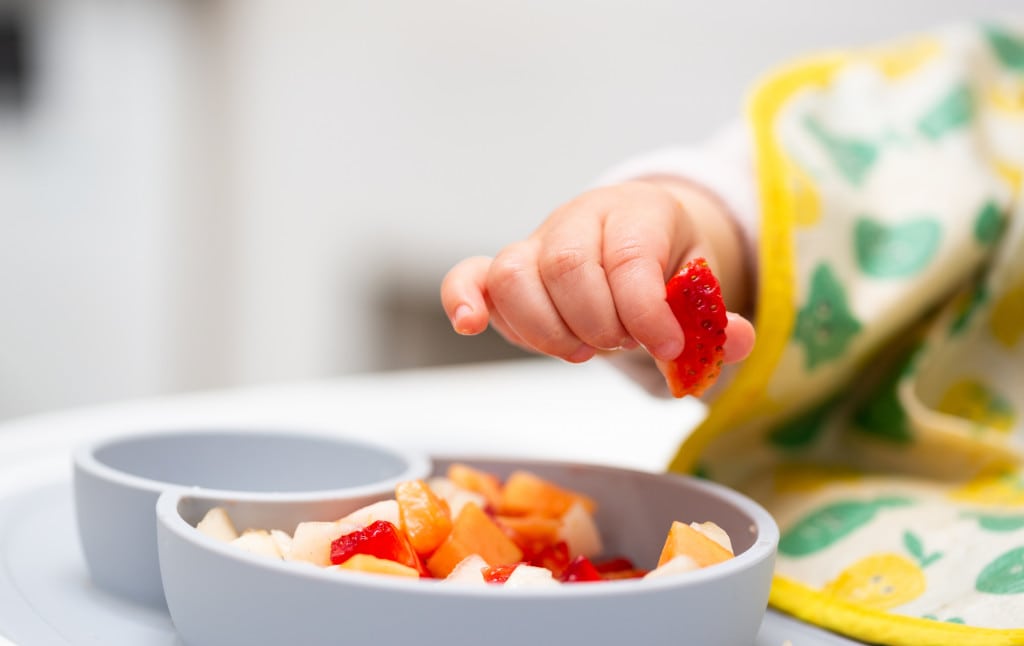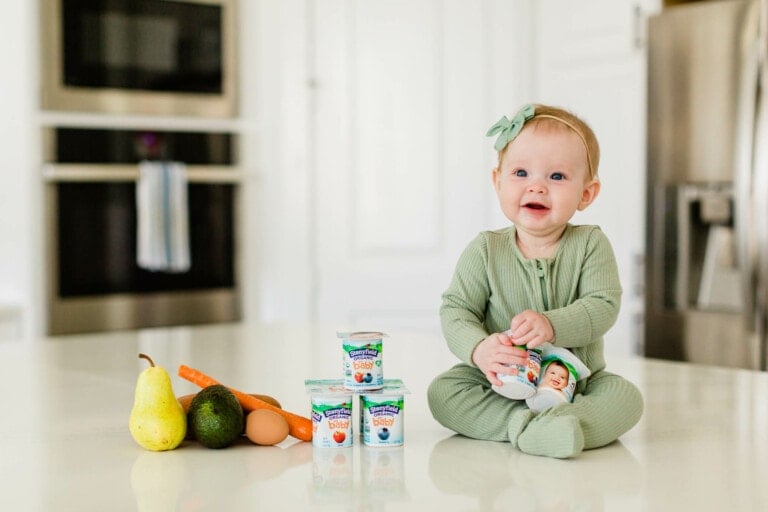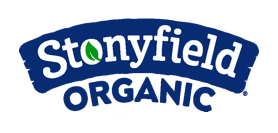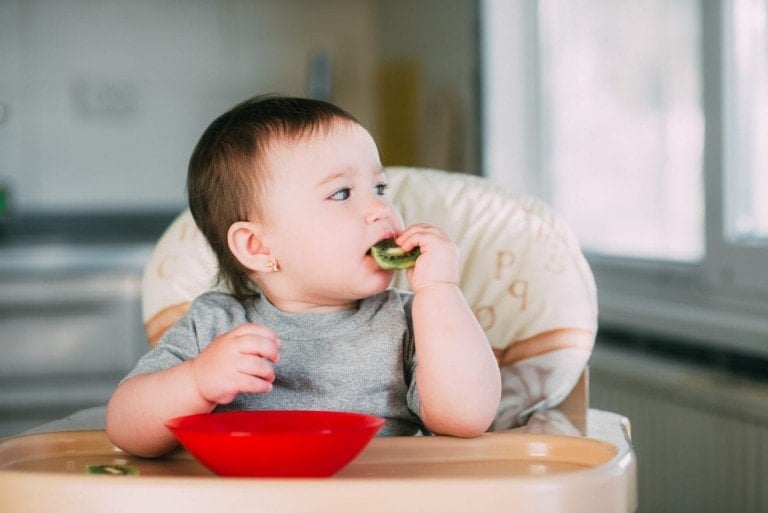Every parent desires their child to be well-nourished, establish healthy eating patterns, eat a nutritious, balanced diet, and grow to their potential. No parent would choose for their child to become a picky eater, struggle with feeding difficulties, or develop food allergies. Why is it important that we are proactive and intentional with introducing solids? Could when and how your infant begins eating food make any difference? Actually, yes, we now know that it can.
Feeding our babies can be deeply personal and rooted in one’s family, history, and culture. This journey with your child is unique and your own. What is right for you may not be suitable for another family. However, it is important to remember that for the first year of life, all babies will continue to get most of their nutrition from breastmilk and/or formula even after you begin to supplement with solid foods. You will continue providing your baby with breastmilk and/or formula to ensure they receive the necessary nutrients to thrive.
Your child’s nutrition is extremely important and critical to their overall health and well-being. I discuss this with my patients’ caregivers at every checkup. It is crucial that you speak to your pediatric healthcare provider about your child’s specific needs, talk through their recommendations, and develop a personalized plan together.
When is the right time to introduce solids?
So when is the right time? Well, that answer ultimately will depend on your child. Around four months of age, you will want to start paying attention to see if your child displays any signs of readiness. This is more important than chronological age in deciding when to introduce solid foods. For example, some babies may be ready at four months, while others may not be until six or seven months. The American Academy of Pediatrics offers cues that your baby may be ready, including:
- sits up mostly on their own, with the support of a high chair or infant seat
- has good head and neck control
- is socially interested in food and eating (they might even try to grab food off your spoon or plate!)
- continues to be hungry after nursing sessions or bottle feedings
- “tongue-thrust reflex” has faded (doesn’t automatically push food out of their mouth with their tongue)
- growing well (babies are usually double their birth weight at the 4-month checkup)
What foods should I start with?
Okay, so you have determined your baby is ready to start solids. Now what? How do you begin? With what foods? And how much? Courtney Nassau, M.A., CCC-SLP, is a pediatric speech pathologist in Louisville, Kentucky, who specializes in infant feeding. She shares: “As with most things in parenting, there is no one way that is best to introduce solids. It is perfectly appropriate to start with purées, large pieces of solid table foods, OR a combination of these.”
There is no one specific food you must start with, and the amount eaten is even less important. You can offer food in puréed form or finger foods as in the “baby-led weaning” approach. The order in which foods are introduced (vegetable, fruit, grain, or meat first) is probably less important than the texture and consistency of the food. Your goal should be to expose your infant to a wide range of flavors, colors, and textures. Babies who consistently try new and different foods are less likely to become picky eaters and may get more nutrients, too.
What if my child chokes or gags?
It is normal and expected for a parent to be apprehensive as they get ready to feed their baby solid foods for the first time. Relax, and don’t approach this stage feeling pressure or with terror! Your little one can feel that and may become afraid of the foods themselves. Remember, this should be fun and not scary!
Courtney Nassau advises: “Know the difference between choking and gagging. Choking is an emergency and needs your intervention. Gagging is a normal, appropriate, and necessary part of feeding development. Don’t panic or intervene when you see gagging. Stay calm and let baby work through it, and continue to offer that food.”
When do I offer my baby water?
Around the same time you begin solids, you may introduce a sippy cup of water. You can give up to 4-6 ounces per day of water intake as long as they continue to take their breastmilk and/or formula. We don’t want little ones to fill up on water and miss out on the necessary calories and nutrients offered in breast milk, formula, and/or solid food. Sugary drinks (even 100% juice!) add unneeded calories, lack nutritional value, and can harm your baby’s teeth. Introducing a sippy cup around six months of age will encourage oral motor development and help us reach our goal of weaning off the bottle after 12 months of age.
What if my baby doesn’t like what I offer?
Be patient with your little one if they don’t seem to like particular foods. And don’t give up! It can take 10 to 20 exposures over several months for a child to get used to and accept a new food. Also, allowing your child to develop fine motor skills by self-feeding when possible is okay. Letting them explore, touch, and even play with different foods is fun for them and can help avoid sensory processing difficulties later. Even the food they put in their mouth and spit out is a win. The mess they create is important and you can always clean it up.
How do I know my baby is full?
Just as there are signs that your baby may be ready to start eating, there are also cues that they are finished. They may lean forward and open their mouth when interested in food, and lean back and turn away or keep their lips closed when uninterested in the food or no longer hungry. Don’t force them to eat. Your baby is developing important eating skills, including understanding and trusting their hunger and fullness cues.
I often tell parents they are in charge of what they prepare for their child and where their child will eat. Their child decides if they will eat and, if so, how much. Mealtime becomes a perfect opportunity to teach other lessons and manners from day one, such as good eating habits, sitting down together, and the importance of family meals. At one year of age, the goal is for your child to eat three meals a day with a snack or two, use a drinking cup instead of a bottle, and eat more food than drink.
Should I give my baby allergenic foods?
An essential part of food introduction is the incorporation of allergenic foods. This is a critical conversation you should be having with your pediatrician. Guidelines may change as new studies teach us better ways. Children that are deemed “high risk” for developing allergies include those with at least one first-degree relative (parent or sibling) with an allergic condition, including a documented food allergy, asthma, allergic rhinitis, or atopic dermatitis (eczema). Other studies used risk factors such as moderate to severe eczema or having egg allergy to define “high risk.”
Randomized controlled trials have evaluated the specific timing of introducing highly allergenic foods, such as peanuts and eggs, and the risk of developing food allergies to them. Contrary to what we used to believe, there is now evidence that earlier introduction to these foods may decrease the risk of allergy! The goal is to introduce these foods to infants before 12 months of age. However, some experts recommend that high-risk infants be introduced beginning between four and six months of age.
Can I wait longer to introduce solids to my baby?
There are, of course, benefits of exclusive breastmilk and/or formula until six months of age, as the American Academy of Pediatrics continues to recommend.1 Starting solids later ensures that breastmilk or formula won’t get crowded out of your baby’s diet. It also preserves the breastfeeding relationship between mother and child. But missing the “window of opportunity” and waiting too long can lead to delays resulting in the need for feeding therapy.
You can see now why solid food introduction is so complex and there is no one “right way.” Clear communication with your pediatrician will allow you to create a plan together that you are both comfortable with and that fits your child’s individual needs.
Dr. David Stukus, a pediatric allergist at Nationwide Children’s Hospital in Columbus, Ohio, explains, “We have done a tremendous disservice to parents everywhere by making them think they are going to harm their baby by giving them food to eat. This is not only completely wrong but the opposite of what we should be doing. Babies are resilient and love to try new tastes and textures. Feeding solids should be messy, fun, and a time of joy. Food allergies are rare overall, affecting about 5% of children. If we treat 100% of babies like they’re at risk, that is way too conservative. Even when food allergies first appear, they don’t send babies to the emergency room, they almost always cause a rash or maybe some vomiting. If that occurs, then it can be evaluated.”
What if my baby has an allergic reaction to a type of food?
Although unlikely, it is possible for an allergic reaction to occur the first time a child eats a particular food. The most common symptoms of an allergic reaction seen in infants are hives (skin welts) or rash, and/or vomiting. Other signs and symptoms to watch out for include facial swelling, diarrhea, coughing, wheezing, difficulty breathing, weakness, or pale skin.
Unless instructed otherwise, it is safe for your baby to be given an initial taste of a highly allergenic food at home rather than at daycare or a restaurant. Do so in the earlier half of the day so you can monitor your child. The foods most likely to cause an allergic reaction include dairy, egg, tree nuts, peanuts, shellfish, wheat, soy, and fish. You will need to be creative in how you introduce these foods, especially those that are choking hazards.
For example, apply a thin smear of nut butter or peanut butter on a dissolvable wafer or mix Bamba puffs with breastmilk or formula. You can gradually increase the amounts given if they tolerate it well without a reaction. Once these foods have been introduced, you should keep them in their diet consistently. That is how their immune system learns to be tolerant.
Should I wait to introduce new foods?
It used to be recommended that parents wait anywhere from 2 to 5 days between new foods. However, that is now felt to be unnecessary. I think it is reasonable, however, to introduce a highly allergenic food individually to rule out other contributing factors in case of a reaction. Consult your child’s pediatrician if they have signs of an allergic reaction after ingesting a particular food or if they have moderate to severe eczema that is difficult to control.
Children with sensitive skin may get red skin around their mouth after eating a particular food. Once it is determined not to be an allergy, putting a barrier ointment such as Vaseline or Aquaphor around their mouth before meals prevent this. Washing their face after the meal will help as well. An evaluation with a pediatric allergist may be suggested in these cases for testing and management if your child has developed a food allergy.
Are there any foods my baby should not try?
Just as important as it is to explore new foods and encourage variety, there are some foods that you should continue to avoid. Foods that are choking hazards are not recommended for children younger than four years. This includes whole hot dogs, peanuts and tree nuts, grapes, raw carrots, popcorn, sticky foods, and round candies.
Until 12 months of age, a child should not be given liquid whole cow’s milk. Their digestive tract is immature and unable to process these intact proteins. Dairy products such as yogurt and cheese, however, have proteins that have been broken down in processing and are typically tolerated by infants over six months of age.
You should also wait to feed your child honey until after their first birthday. Honey can cause botulism in infants less than one year. Another no-no is adding food such as cereal to a bottle (unless otherwise directed by a physician). It adds unnecessary calories to your baby’s diet. We want to teach our children to eat their solids and drink their liquids. Some parents hope that introducing solids will help their baby sleep through the night, but studies have shown that you can’t count on that as a result.
Should I worry about my baby getting constipated?
It is normal and expected that your baby’s stools will change in color, frequency, and consistency when introducing solids. Don’t worry! But, if your child’s stool becomes firm or painful to pass, the addition of a sippy cup of water and diet modification may help. The P fruits (peaches, pears, prunes, plums, and apples) or 1-2 ounces of prune juice can help soften stools.
Some last tips . . .
I hope you recognize the hand you have in helping your child develop healthy eating patterns that will contribute to their well-being, growth, and development. These tips for introducing solids are meant to empower you, not to add pressure or shame.
- Keep it simple.
- Offer tasty fruits and/or veggies with each meal.
- Aim for variety.
- Keep water readily available.
- Eat together as a family.
- Role model a healthy, varied, and balanced diet.
- Do not make mealtime a battle.
- Do what seems right to you.
- Don’t stress. Have fun and get messy.
- Stick with it. And keep trying — it’s worth it!
One last thing . . . please do yourself a favor and videotape a few feedings where your child is having the most fun. They tend to make funny faces, laugh, and squeal with excitement. You’ll be happy to have those moments to look back on and reflect on. Introducing solids can be overwhelming and stressful. But please don’t forget to take the opportunity to stop, be present, and enjoy this stage of parenthood. Sit back and soak in these joyful moments with your baby, as they won’t last forever.
Disclaimer: While I am a doctor, I am not your child’s doctor. All content presented in this article is for educational purposes only. It does not constitute medical advice and does not establish any kind of doctor/patient relationship. Speak to your child’s healthcare provider about any questions or concerns you may have.


























